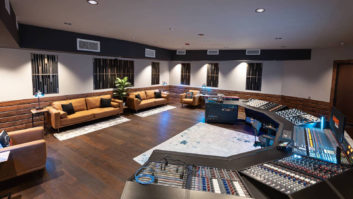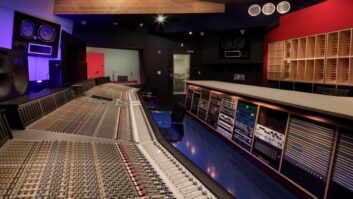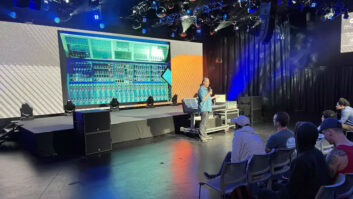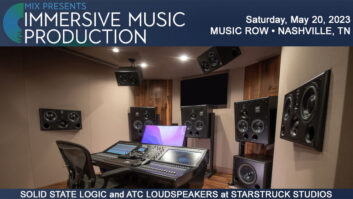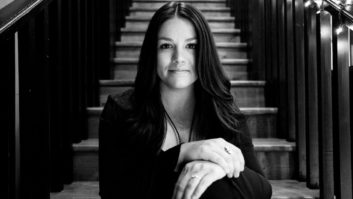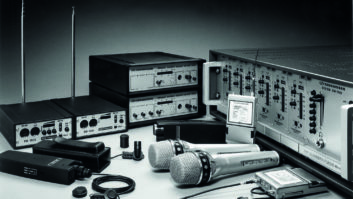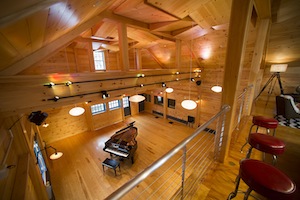
Hearstudios
Photo: Tim Gaudreau
On the Cover: Hearstudios, Camden, Maine
Owner/chief engineer Jason Hearst relocated from Boston to this airy, beautiful new facility in a restored 19th-century grain barn. Despite the rural image that conjures, the facility is situated in downtown Camden, so isolation was an important consideration in the acoustical design by Lou Clark of Sonic-Space (sonic-space.com).
“We tore it down to the studs,” Clark says. “We spray-foamed the entire structure, which made the building more rigid. Then we added batt-insulation and isolation clips, then two layers of drywall. This was done to every surface, including the ceiling.”
The knotty pine that covers the interior of the main tracking room makes for a very live tracking space, but acoustics can be adjusted with variable gobos that Clark and Hearst designed as an alternative to constructing multiple fixed iso booths. “Only one of the three booths is permanent,” explains Clark. “That’s the vocal booth farthest from the control room. To the left of that, he can arrange these gobos on wheels to create a fairly neutral booth environment—a little live, a little dead—and then to the left of that, there’s a very dead space with a lot of trapping. The idea is that he can have different environments to work in, but it also balances out the big live space.”

Hearstudios
Photo: Tim Gaudreau
The gobos were built to fit on-site by Taylor-Made Builders’ Norm Dalholt, who also came up with the clever idea of jacking up the panels once they’re in place to create a seal between the booth(s) and the balcony area above, which provides another potential recording space.
Hearst and studio manager Bob Thompson have been up and running for only a few months, hosting sessions with a variety of local musicians while they get to know the new studio, including the centerpiece of the control room: a brand-new Neve 5088 Portico console integrated by Burt Price. “Rupert Neve put the best aspects of his design history into the 5088—its EQs, compressors and processing modules—so you can take advantage of what people love on one modern system,” Hearst says. “The Portico makes an excellent tracking board to go into Pro Tools, optimizing my workflow.” Hearst’s main monitors are Barefoot MicroMain27s; they listen in 5.1 from BeoLab 3s using Dave Moulton’s acoustic lens. The studio offers an array of outboard gear set in custom racks built by Adam Zois, who also built the cherry conical control room diffusers.
“We also have an amazing instrument selection,” points out Thompson, who’s known in New England as an in-demand guitarist, university instructor, and former New England sales manager for Fender Musical Instrument Corp. “You can see only the Yamaha C7 concert grand in these pictures, but we also have a B-3 with two Leslies, a Rhodes 88 and a Wurly; plus, there’s what Jason calls the ‘Guitarsenal.’ We have several dozen incredible guitars, vintage and contemporary amps, and many other types of instruments. There isn’t any style of music that can’t be created with authenticity here.”
For Hearst, this latest incarnation of Hearstudios (the third that Clark has designed with him) isn’t just a superb, loaded new workspace; it’s also a place to put down roots. “I grew up one town over from Camden,” he says. “So this was moving back home for me. We were looking back and forth between properties in Boston and here, and this was the place that had the yard for the kids, the house for our family, and a barn to fulfill my dream of creating a versatile studio with a great vibe.”

DreamWorks Animation SKG
Photo: Juergen Nogai
DreamWorks Animation SKG, Glendale, California
Peter Grueneisen, FAIA, of nonzeroarchitecture and studio bau:ton (nonzeroarch.com) designed this TEC Award-winning recording studio and premix stage for DreamWorks Animation. The facility’s location in the basement of an office building posed spatial problems that the designer solved with a three-dimensional arrangement of single- and double-height spaces; space planning and isolation were key issues in the design. The 850-square-foot recording room with 18-foot ceilings includes suspended clouds that conceal air ducts and lighting, as well as function acoustically and aesthetically. The control room pictured is connected to the recording space via a large window and through a sound lock. An additional producer’s booth in the back of the room provides an extra quiet and private space. The extensive equipment list features Euphonix S5 Fusion digital mixing consoles/S5 MC systems, Pro Tools systems, Genelec 8040 main monitors and PMC surrounds.

Laboratoire Audionumérique de Recherche et de Création (LARC)
Photo: Dragos Chiriac

Laboratoire Audionumérique de Recherche et de Création (LARC)
Photo: Dragos Chiriac
Laboratoire Audionumérique de Recherche et de Création (LARC), Quebec City, Canada
Pilchner Schoustal International (pilchner-schoustal.com) designed this multistudio complex for the Université Laval. Four control rooms face onto a large tracking room that includes two fixed iso booths and a collapsible booth with moving wall assemblies. The control rooms employ controlled-reflection geometry to provide uniform response characteristics, while the live room features low-frequency trapping and specular absorbers for a smooth decay and even performance. Key equipment in this facility, which opened in April 2013, includes SSL 4000 G+ and Soundcraft 2400 consoles, Studer tape machines and Pro Tools systems, with a wide palette of processing options and microphones.

Lucky Post Audio Suite
Photo: Russ Berger Design Group
Lucky Post Audio Suite, Dallas, Texas
This audio suite, with control room and iso booth, is part of the 7,100-square-foot Lucky Post facility designed by the Russ Berger Design Group (rbdg.com). The studio went online in May 2012 and is integrated with three video-edit rooms. Featured equipment includes a Pro Tools HDX system with a 32-fader Icon D-Control console. Monitoring is via a Genelec 5.1 DSP system offering multiple calibration setups. Also on hand is a full complement of plug-ins from Waves, Sonnox, iZotope, Avid and Audio Ease.

Easy Eye Sound
Photo: Bill Lafevor
Easy Eye Sound, Nashville
The acoustics in Easy Eye Sound, the personal studio of Black Keys frontman and the Recording Academy’s reigning Producer of the Year, Dan Auerbach, were redesigned by Steven Durr (stevendurr.com) to be warm and natural-sounding, allowing for performances to be captured with little or no baffling. Excellent sight lines allow for good communication and flow during sessions. Constructed by Dave Mattingly of Sound Construction, Easy Eye Sound reopened in June 2012, retaining its previous equipment complement including a Spectra Sonics 1020 16-bus console, Scully 280A 16 track 2-inch and 8-track 1-inch recorders, Pro Tools HDX with Lynx converters, RADAR, and monitors by Equator Audio, Dynaudio and Altec.

MG Sound
Photo: Martin Moravek
MG Sound, Vienna, Austria
This studio complex designed by Andy Munro and Chris Walls of Munro Acoustics Ltd. (munro.co.uk) comprises three main studios, several live rooms, editing facilities and a mastering room, as well as reception and office areas. Architect Roland Gasperel designed the interiors and provided project management. The acoustic design was based on a fully modular concept, with proprietary modeling and design programs used to produce custom bass absorbers and diffusers. Spread out over three floors of a former bank in the heart of Vienna’s old city, the studios opened in several phases throughout 2012 and 2013. Rooms are equipped with SSL 9000 consoles, Pro Tools systems and Studer A800 tape machines, and monitoring is by Dynaudio Acoustics, Genelec and ATC.
Watch a video in which Andy Munro speaks with Mr. Bonzai about the new MG-Sound in Vienna, Austria.

The Vault Mastering Studio
Photo: John Brinkman
The Vault Mastering Studio, Phoenix, Arizona
Engineer/studio owner Nathan James, who has mastered recordings for The Fray, Louis C.K. and others, has moved his business from Manhattan back to his hometown, Phoenix. James’ new 300-square-foot facility, designed by Walters Storyk Design Group (wsdg.com), went online in February. Acoustical features include a front wall treatment comprising three overlapping, curved, fabric-wrapped absorptive panels, and a corresponding ceiling cloud and rear-wall panel. WSDG also devised a hinged, 6-foot-wide, absorptive acoustic window treatment built with Clearsorber Deamp perforated transparent panels. James brought his full NYC equipment setup to the new Vault: custom DM console, Duntech Sovereign/Cello amp monitoring, and processing from Lavry, Prism, Sontec and Manley.

Strange Weather
Photo: Wes Lachot
Strange Weather, New York City
Wes Lachot (weslachot.com) designed this facility to be used for owner/engineer Marc Goodman’s music tracking and mixing projects. The studio was completed in December 2012 and was built by Brett Acoustics, with wiring by Canova Audio. The control room features a sidewall treatment that helps to extend a wide reflection-free zone to the back of the room. Tracking room treatments include variable-depth absorptive and diffusive modules. The control room features a 48-channel API 1608 console, Dynaudio M3A main monitors powered by Bryston amps, Pro Tools 10 and two Studer A820 tape machines. Also available are processing options from Neve, Pultec, ADL, Gates, RCA, Bricasti, Lexicon, Eventide and more; there is also an EMT 140 plate reverb and a Yamaha C3 grand.

BrokenWorks Productions
Photo: Jim Chamberlin

BrokenWorks Productions
Photo: Jim Chamberlin
BrokenWorks Productions, Ashland, Oregon
Purpose-built with live tracking in mind, this 1,100-square-foot home addition was designed by Chris Pelonis of Pelonis Sound and Acoustics (pelonissound.com). The studio comprises a live room and two isolation booths with line-of-sight between each space and the control room; ergonomic workflow and lifestyle were important considerations, and Pelonis developed a design that provides isolation as well as accuracy and musicality. Rick Ruzzamenti of Sound Waves provided finish carpentry on the project. Key equipment includes Pelonis’ Model 42 monitors with 42LF subwoofer; mic pre’s from Neve, API, UA and Focusrite; and a variety of microphones from Neumann, AEA, Mojave, Shure, Audix and Heil Sound.

Volant Studios
Photo: Mark Benigno
Volant Studios, New York City
This spacious Tribeca studio, which opened in March 2013, includes a 25×28-foot control room and 30×35-foot tracking room with 13-foot ceilings and variable acoustics. Horacio Malvicino of Malvicino Design Group (malvicinodesigngroup.com) provided acoustical design, with help from his firm’s system integrator, Inaki Prades. Equipment, supplied by Guitar Center Pro of New York City, includes an SSL AWS 948 console, a Studer A80 machine, CLASP, UREI 813 and ADAM SX-V monitors, and Pro Tools HD-X2. Processing is via outboard gear and plug-ins from Bricasti, Lexicon, API, Neve, GML, Manley and Empirical Labs.

Middle Tennessee State University Studios D and E
Photo: Lou Johnson
Middle Tennessee State University Studios D and E, Murfreesboro, Tennessee
The highly regarded Recording Industry Department at MTSU hired Carl Tatz Design (carltatzdesign.com) to revamp two studios/classrooms. The rooms feature a custom application of the new Carl Tatz Signature Series control room acoustic modules by Auralex. They also received new monitoring via Tatz’s proprietary PhantomFocus system, utilizing Genelec 1037C active monitors. Other equipment in these two identical rooms includes SSL AWS 924 consoles, Pro Tools 10 HDX systems, API Lunchbox with several 500 Series modules, and more processing from Empirical Labs, Drawmer, Eventide, TC Electronic, Lexicon and Yamaha.

Baoli Records
Photo: Frederick Alexis
Baoli Records, Port-au-Prince, Haiti
This 350-square-foot control room redesigned by Jeff Hedback (hdacoustics.net), reopened in August 2012. New treatments include a teak-finished membrane bass trap across the front of the room and modular treatments from RPG Acoustics, Primacoustic and Ready Acoustics. The room offers clear sight lines into the tracking room and is equipped with an SSL AWS 924 console, a Pro Tools HDX system, custom-built AudioKinesis mains, and Barefoot MM127 monitors. The studio also features a selection of vintage and modern microphones, and processing from Avalon, Shadow Hills, Universal Audio, API, Pultec and Neve.

MBK Entertainment/OZ Studios
Photo: Cheryl Fleming
MBK Entertainment/OZ Studios, New York City
This 7,800-square-foot complex on a high floor offers sightlines from both control rooms through two live rooms and views of the river and city beyond. Designed by Walters Storyk Design Group, the rooms have floating floors and are treated with FlutterFree diffusers and low-frequency absorbers. The 190-square-foot control room A, connected to the 230-square-foot control room shown here, is equipped with a 24-input SSL Duality SE console, Logic Pro, Pro Tools HD3 and Augspurger custom mains. Studio B, attached to a 60-square-foot sound booth, offers an SSL Matrix board and ADAM S5X-V monitors.

Prestonwood Baptist Church Studio B
Photo: Larry Brubaker
Prestonwood Baptist Church Studio B, Plano, Texas
This first ZR prefab Virtuoso control room was designed by Hanson Hsu of Delta H Design (deltahdesign.com) in L.A., manufactured by Clair Brothers Systems in Pennsylvania and then assembled on-site in Texas. The parallel manufacturing and design process made it possible to complete this project in 11 weeks, with the studio going online in September 2012. New Lipinski 707A Signature Series main monitors, ADAM S3XH near-fields and a Digidesign ICON console upgrade, combined with Pro Tools 10 and pre’s from API and Avalon, make this a desirable new studio location.

Coast Recorders
Photo: Dan Ransom
Coast Recorders, San Francisco, California
Tom Richardson and Desmond Shea redesigned and rebuilt the control room run by chief engineer Sean Beresford at the venerable Coast Recorders, owned by Michael Romanowski. The tracking room retains its original acoustical design by Bill Putnam but received needed upgrades to the electrical system and lighting. Reopened in October 2012, the studio is centered around a 36-input Rupert Neve 5088 console and ATC SCM150ASL monitors. There is also an extensive amount of outboard gear along with a Studer A827 and Pro Tools. The rebuild of the control room allowed the walls to be repositioned and properly treated so that no EQ room correction is required.

Everywhere Audio
Photo: Courtney Chavanell
Everywhere Audio, Austin, Texas
Owner Marty Lester left his longtime position as chief engineer at Tequila Mockingbird Studios to open his own room within a new production collective called Black Market Digital. Focused mainly on sound for ads and TV, as well as music clients (Apple, BMW, Nissan, Ani DiFranco, Jack Black), the studio features acoustics/custom treatments designed by Mark Genfan of Acoustic Spaces (acousticspaces.com). The control room pictured adjoins an iso booth and has tielines to the other facilities in the complex. Equipment: Avid Pro Tools HD, Metric Halo Labs ULN-8, Alesis HD24XR, MOTU Traveler, Tascam DR-40 recorder and 5.1 Neumann KH120 monitors with a Rythmik Audio F15HP subwoofer.

77 Recording
Photo: Alex Morgan
77 Recording, Evansville, Indiana
Transplanted Nashville producer/engineer Jimmy Dulin works out of this 2,700-square-foot facility, designed by Gavin Haverstick of Haverstick Designs (haverstickdesigns.com), which comprises a control room, live room, drum and vocal booths, amp room, lounge and lobby. Isolation issues were addressed with a concrete slab cut between rooms to reduce vibration transfer. In addition, QuietRock 545 was used in the wall-layering scheme for noise-sensitive areas. Custom wood diffusers were designed for the live room, and custom bass trapping was implemented on the rear wall and ceiling of the control room, which is equipped with a 48-channel API 1608 console with 32 channels of automation. and Barefoot MicroMain27 and Yamaha NS-10 monitors.

Red Lounge Studio
Photo: Alex Romero and Kevin Roahrig
Red Lounge Studio, Tampa, Florida
Studio owner Andres Orjuela and his chief engineer, Alex Romero, designed this music-recording/mixing studio, where they employed bamboo flooring and a range of Auralex’s prefabricated absorptive panels and bass trapping in the 29×20-foot control room and 17×23-foot tracking room. Owner and engineer also hand-built custom oak diffusers, which are installed behind the Avid Control 24 console and on side walls. Opened in April 2012, Red Lounge also features Pro Tools HD10, Apogee interface and converters, and UREI 811C main monitors. Engineers at Red Lounge include Romero, James Wood and Chad Norman.
